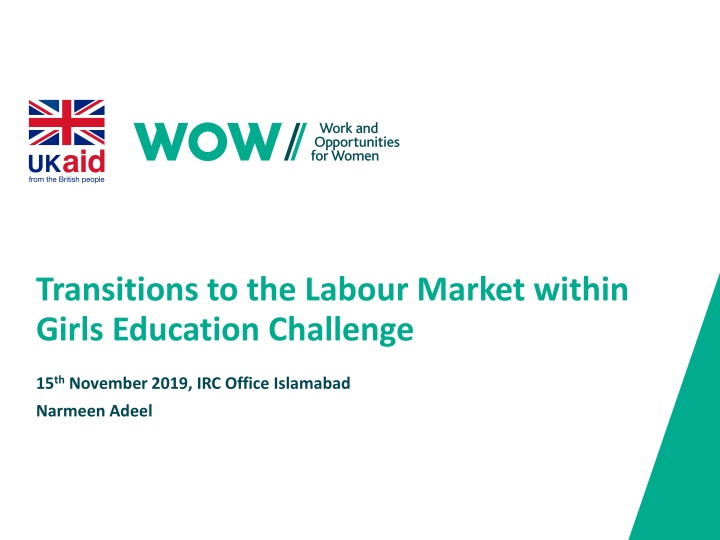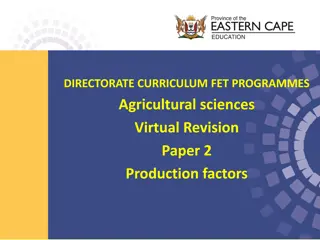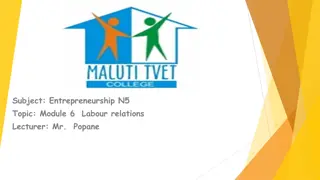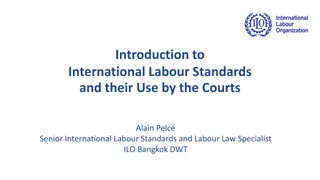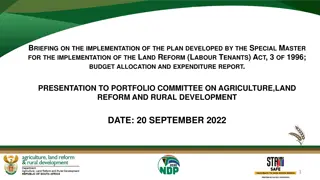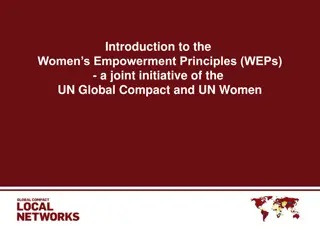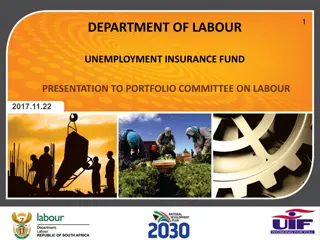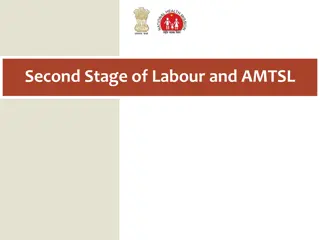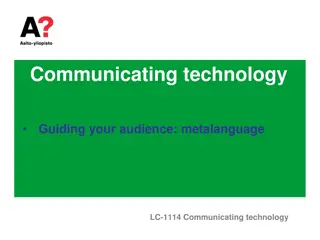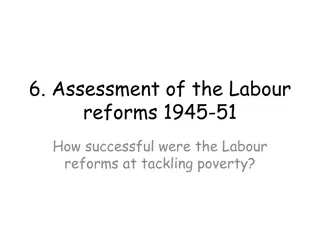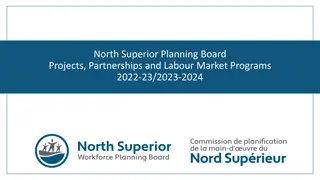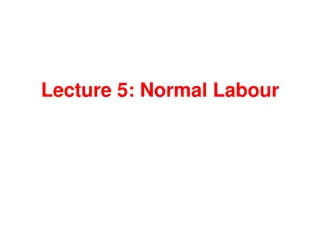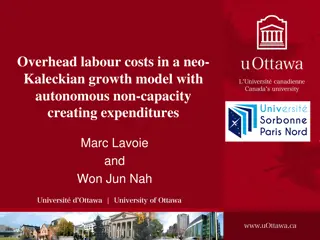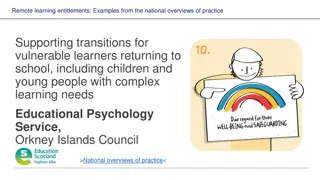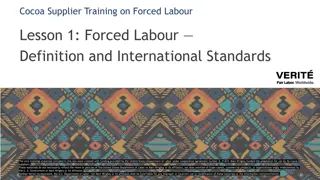Transitions to Labour Market Strategies for Economic Empowerment
This report delves into potential strategies supporting older girl adolescents in transitioning from education to securing better jobs and adulthood in various provinces. It explores ways to enhance program designs like Closing the Gap and TEACH for sustainable outcomes in economic empowerment, outlining possible indicators and impact pathways. The overview covers the significance of women's economic empowerment, including drivers and regional contexts, alongside specific GEC projects in Pakistan focusing on adolescent girls' education and skill development.
Download Presentation

Please find below an Image/Link to download the presentation.
The content on the website is provided AS IS for your information and personal use only. It may not be sold, licensed, or shared on other websites without obtaining consent from the author.If you encounter any issues during the download, it is possible that the publisher has removed the file from their server.
You are allowed to download the files provided on this website for personal or commercial use, subject to the condition that they are used lawfully. All files are the property of their respective owners.
The content on the website is provided AS IS for your information and personal use only. It may not be sold, licensed, or shared on other websites without obtaining consent from the author.
E N D
Presentation Transcript
Transitions to the Labour Market within Girls Education Challenge 15thNovember 2019, IRC Office Islamabad Narmeen Adeel
Introduction This report addresses the following questions: What are the potential entry points to supporting older girl adolescents (15+) in transitioning from education to gaining better jobs and transitions to adulthood in FATA (newly merged districts of KP), Sindh, and Baluchistan provinces? How can the design of Closing the Gap and TEACH be strengthened to maximise the potential for transformative and sustainable outcomes for girl s/women s economic empowerment? What indicators could be used in Closing the Gap and TEACH to measure successful transitions from education to the labour market and adulthood, and what are the pathways to impact? 2 | Transitions to the Labour Market within Girls Education Challenge
Overview of Womens Economic Empowerment (WEE) Women s economic empowerment is a key component in DFID s Strategic Vision for Gender Equality (2018) The concept is commonly associated with skills and capacities that make it possible to progress economically, as well as the power to act and make economic decisions. WEE lays the foundation for educated, confident and well- rounded adulthood The role of social and human capital becomes more pronounced since young girls are less likely to own physical assets 3 | Transitions to the Labour Market within Girls Education Challenge
Drivers of WEE 4 | Transitions to the Labour Market within Girls Education Challenge
Regional Context 5 | Transitions to the Labour Market within Girls Education Challenge
GEC Projects in Pakistan Closing the GAP (ACTED) and TEACH (IRC) Focus on adolescent girls aged 10-19 Accelerated Learning Program for younger girls Short courses that include literacy and numeracy training, life skills and technical training for 13/14+ girls Courses for technical skills have not been finalized yet and depend on local needs assessments 6 | Transitions to the Labour Market within Girls Education Challenge
Closing The Gap Objective: The overall objective is to support out-of-school adolescent girls (aged between 10 and 19, who were dropped out of the education process or never attended a school) to receive non-formal education, gainful skills training, and relevant employment opportunities for improving quality of their family lives and linking with formal education process. The project aims to address two basic barriers for girls to education: 1) lack of access to education; and 2) social and cultural barriers. Target Beneficiaries and Areas:5,500 girls between 10-19 years of age in Sindh (Jacobabad and Kashmore districts) and Newly Merged Districts of KP/Previously FATA region (Mohmand and Bajaur agencies). Partners: Right to Play, Adult Based Education Society (ABES) Current Status: The project is set to initiate field activities by November 2019 including baseline, teachers identification, training and centre establishment for first set of literacy and numeracy centres in Sindh under first short-term learning stream cohort. 7 | Transitions to the Labour Market within Girls Education Challenge
Closing the Gap Program Design: The Closing the Gap program has two components: the Accelerated Learning Program (ALP),and short term skills based courses. Cross cutting activities: School Management Committees Learning Centres 8 | Transitions to the Labour Market within Girls Education Challenge
TEACH Objective: to bring lasting improvement in learning outcomes for girls, to transition them to formal schools wherever possible and appropriate, and to enable them to gain market-relevant livelihood and life skills The project aims to address two basic barriers for girls to education: 1) lack of access to education; and 2) social and cultural barriers. Target Beneficiaries and Areas:35,000 girls in Baluchistan (Nushki, Kharan, Chaghi, Pishin, Killa Abdullah districts). Partners: Baluchistan Education Foundation (BEF), Developments in Literacy (DiL Pakistan), Tameer-e-Khalq Foundation Current Status: TEACH project has just started its implementation phase. Community mobilization has started and consortia partners are in the process of identification and selection of clients, villages and centres. 9 | Transitions to the Labour Market within Girls Education Challenge
TEACH Program Design: The TEACH program has two components: the Accelerated Learning Program (ALP),and employment skills based courses. Cross cutting activities: Support to Public Education Department Awareness and Outreach Village Support Groups 10 | Transitions to the Labour Market within Girls Education Challenge
What are the potential entry points to supporting older girl adolescents (15+) in transitioning from education to gaining better jobs and transitions to adulthood in FATA (newly merged districts of KP), Sindh, and Baluchistan provinces?
Entry Points to Supporting Older Girl Adolescents (15+) in Transitioning The term transition refers to a progressive shift in an individual s personal or professional life. A successful transition therefore, is one where an individual is capable of taking a step forward towards realising her potential. There are two key indicators of successful transitions, in the context of this presentation. Access to better jobs and new economic opportunities for adolescents. Enhanced agency of girls and young women. It is important to note that the onus for ensuring both these outcomes cannot be entirely on the individual. 12 | Transitions to the Labour Market within Girls Education Challenge
Challenges to Transition Pathways Older adolescent girls in these provinces face four key challenges which could hinder their transition pathways: skills gaps information gaps aspiration gaps adverse social norms There are three key entry points, to support older adolescent girls to make successful transitions Enhancing access to education and training Outreach to motivate girls to learn Coaching and mentorship support to improve learning outcomes and transitions Successful transitions Individual level Enhanced agency of adolescents and girls Peer learning support Safe spaces for girls to communicate and interact Peer networks to connect adolescent girls to new economic opportunities Peer to peer Enhanced access to economic opportunities Family and community based organisations for girls/women, by girls Education/training institutions Local government Institutional 13 | Transitions to the Labour Market within Girls Education Challenge
How can the design of Closing the Gap and TEACH be strengthened to maximise the potential for transformative and sustainable outcomes for girl s/women s economic empowerment?
Overview of Existing Program Design Elements Contributing to Economic Empowerment of Adolescent Girls: Tackling adverse norms and promoting positive role models Building assets - digital, financial and property Changing business culture and practice - provision of business grants and toolkits to select girls financial literacy and life skills training linkages with MFIs and VSLAs - reaching out to local business owners and industry to conduct a needs assessment of required skills job placement assistance - reducing discriminatory practices through education enhancing agency and empowerment of adolescent girls through the life skills curriculum encouraging greater awareness for gender equality and empowerment through media outreach identification of positive role models as 'mentors public deliberation on social norms through quarterly meetings with the community - - - - - - - 15 | Transitions to the Labour Market within Girls Education Challenge
Strengthening the Program Design to Maximize Potential Tackle adverse norms and promote positive role models 1. Emphasize the development of agency for adolescent girls through the curriculum and extra-curricular activities 2. Introduce outreach activities targeted specifically toward male members of the community 3. Explore the involvement of male mentors to supplement female role models 4. Introduce (or in the case of TEACH expand the scope of) media outreach through low-cost measures (radio, SMS etc.) to generate awareness 5. Create a community mapping of support services for women and provide all beneficiaries information 6. Create a formal role/agreement for beneficiary girls to become mentors within the community after graduation 1 Enable legal protection 1. For beneficiaries that are 18 or older, the program should encourage registration for the Computerized National Identity Card (CNIC). 2 16 | Transitions to the Labour Market within Girls Education Challenge
Strengthening the Program Design to Maximize Potential Recognize unpaid work and care 1. introduce formal courses and certification for these roles, such as skills training for housekeeping, childcare and elderly care 2. Conduct a needs assessment to explore whether offering child care facilities at the centre would encourage greater attendance Build digital and financial assets 1. Incorporate and emphasize digital literacy within the curriculum 2. Emphasize the procedure and advantages of opening a physical bank account 3. Build stronger linkages with and exposure to MFIs 3 4 Change business culture and practice 1. Explore opportunities with local industry and business owners whereby beneficiary girls can seek employment along with a male member of their family 2. Explore the introduction of formal skills courses in local trades conventionally done by women (such as carpet-weaving, embroidery, bangle-making, cotton- picking) and expand the scope to develop greater female participation in the value chain Strengthen visibility, collective voice and representation 1. Form Self Help Groups (SHGs) in collaboration with the BISP Beneficiary Committees (BBC) wherever possible 2. Explore the development of work collectives 5 6 17 | Transitions to the Labour Market within Girls Education Challenge
What indicators could be used in Closing the Gap and TEACH to measure successful transitions from education to the labour market and adulthood, and what are the pathways to impact?
Defining Success An analysis of programme documents and interviews with programme staff brought out the point that defining success is complex. During initial discussions, success was defined in numerical terms, using indicators such as: achieving specific learning outcomes, transition rates, etc. While there was recognition that empowerment of girls and women was a key intended outcome of the programme there were few indicators to measure this. Existing indicators measure indicators revolving around three key areas i.e. learning, transitions and sustainability. 19 | Transitions to the Labour Market within Girls Education Challenge
Enhancing Program Evaluation Impact evaluation approach can be strengthened by incorporating measures of the reduction of vulnerability and enhancement of agency within beneficiary girls through Socio-emotional behavioural survey Tracer study Value Addition of these tools Captures girls own understanding of empowerment Captures changes in social and behavioral norms (if any) Qualitative studies provide opportunity to explore social dynamics and causes of change in detail Tracer study helps see change over long term and gauge sustainability 20 | Transitions to the Labour Market within Girls Education Challenge
Contacts For further information, please contact: Narmeen Adeel, Research and Evaluation Consultant m: +92 307 4444088 e: narmeen.adeel@gmail.com
This document is an output from a project funded by UK aid from the UK government. However, the views expressed and information contained in it are not necessarily those of or endorsed by the UK government who can accept no responsibility for such views or information or for any reliance placed on them. This publication has been prepared for general guidance on matter of interest only, and does not constitute professional advice. The information contained in this publication should not be acted upon without obtaining specific professional advice. No representation or warranty (express or implied) is given as to the accuracy or completeness of the information contained in this publication, and, to the extent permitted by law, no organisation or person involved in producing this document accepts or assumes any liability, responsibility or duty of care for any consequences of anyone acting, or refraining to act, in reliance on the information contained in this publication or for any decision based on it.
